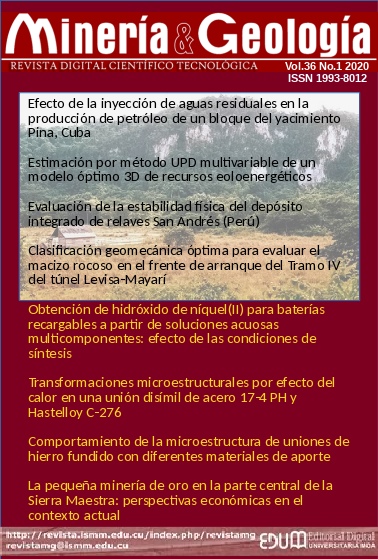Optimal geomechanical classification for evaluating the rock mass from coalface Section IV of Levisa-Mayarí tunnel
Keywords:
tunneling, East-West Trasvase, geomechanical classification, cracking, Levisa-Mayarí tunnel.Abstract
The East-West Trasvase engineering work, designed to drive water from Nipe-Sagua-Baracoa mountain range Rivers to the northern Holguín-Camagüey plains, includes building canals, dams and tunnels. During the work on section IV of Levisa-Mayarí tunnel, there were instability problems with the perforated mass. This research was intended to evaluate several geomechanical classifications (Barton-Q, Bulichev-S, Bieniawski-RMR, and Hoek-GSI) for choosing the most appropriate one and adjusting its parameters to the rock mass characteristics. Cracking was evaluated by parked approximately 1.50 m, according to the progress of the tunnel and by lithology. For data processing, Dips v5.0 and Unwedge v3.0 softwares were used; the adjustment of geomechanical parameters was performed by using the trial and error method. There are three cracks families which predominate in the rock mass and its quality is classified from poorly to bad. It is concluded that Hoek and Marinos’ GSI classification with correlation adjustments with the sclerometer and the Barton Q quality index are the ones that best suit the particularities of the rock mass studied, being the latter who best results offer to project support solutions.Downloads
References
Barton, N. 1974: Estimating the shear strength of rock joints. 3rd. ISRM.
Bieniawski, Z. T. 1989: Engineering rock mass classifications: a complete manual for engineers and geologists in mining, civil, and petroleum engineering. John Wiley & Sons.
Blanco-Blázquez, J. L. 2015: Informe Ingeniero Geológico integral Trasvase Este-Oeste. Tramo Sagua Mayarí. Túnel Levisa-Mayarí. Tramo IV y Túnel de Conexión 3. Ingeniería Básica. INRH, Holguín.
Dans, E. 2017: Entrevista en la revista Madresfera Consultado: 11/09/2018. Disponible en: http://entreparentesis.org/prueba-y-error/
González de Vallejo, L. 2002: Ingeniería Geológica. Madrid. 744 p.
Hoek, E.; Marinos, V. and Marinos, P. 2005: The geological strength index: applications and limitations. Bull Eng Geol Environ, 64: 55–65.
Ochoa, Q. A. y Zaldivar, H. A. 2016: Informe de la Asistencia Técnica a los Frentes de Trabajo en el Túnel Levisa-Mayarí. Trasvase Este Oeste. Tramo Sagua-Mayarí (túnel Levisa-Mayarí). Tramo IV. Ingeniería de Detalle. Archivos Técnicos Raudal, GeoCuba Oriente Norte. Holguín.
Quispe, E. 2013: Método de Prueba y Error en Excel. Consultado: 22/10/2018. Disponible en: http://elmerzinho.blogspot.com/2013/03/metodo-de-prueba-y-error-en-excel.html
Published
How to Cite
Issue
Section
Copyright (c) 2020 Alexander Ochoa-Quesada, Maday Cartaya-Pires, Jorge Luis Blanco-Blázquez

This work is licensed under a Creative Commons Attribution-NonCommercial 4.0 International License.
- Authors retain copyright and guaranteeing the right magazine to be the first publication of the work as licensed under a Creative Commons Attribution-NonCommercial that allows others to share the work with an acknowledgment of the work's authorship and initial publication in this journal.
- Authors may establish separate supplemental agreements for the exclusive distribution version of the work published in the journal (eg, place it in an institutional repository or publish it in a book), with an acknowledgment of its initial publication in this journal.
- Authors are allowed and recommended to disseminate their work through the Internet (e.g., in institutional telematic archives or on their websites) before and during the submission process, which can produce interesting exchanges and increase citations of the published work. (See The effect of open access)










